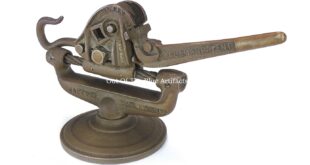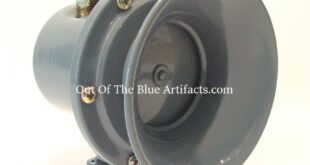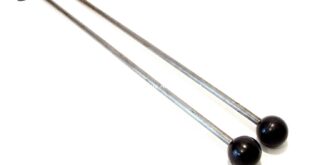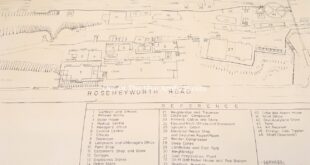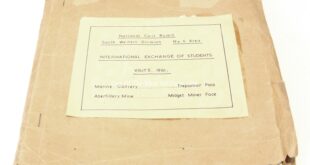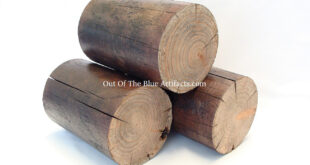N.C.B. Toilet Roll. A toilet roll manufactured for the National Coal Board to be used in their colliery pithead baths. Made from thin brown paper. Size 4 1/2″ x 3″ inches. The roll has been scored in a zig-zag pattern along its width for tearing at every 6″ inches and the words “National Coal Board” is printed with black ink …
Read More »Miscellaneous
Panzer Chain Scraper Links
Panzer Chain Scraper Links. This is a pair of panzer chain scraper links. Made from Iron. Size 4″ x 3″ x 1″ inches. These links were used to hold the scraper bars to the chain on the pans of the panzer chain scraper. The chain scrapers were used to convey the coal and stone from the coal face and also …
Read More »James W. Smallman – Rope Clip
James W. Smallman – Rope Clip. A James W. Smallman – Rope Clip, this exact replica of the larger model used in collieries is either a tradesman’s sample or a commemorative model made by the James W. Smallman company of Nuneaton, England and given to members of the company. Made of iron. Size 7″ x 4″ inches. This miniature rope …
Read More »Underground Klaxon Horn
Underground Klaxon Horn. A small mechanical klaxon horn. Used in the mining industry to alert men to the dangers of moving machinery such as coal cutters etc or maybe to be alerted to any shotfiring. Made from iron and brass. Size 6″ x 5″. They were housed in a steel box with a lever to press to activate the plunger …
Read More »Domestic Fireside Pokers
Domestic Fireside Pokers. A set of domestic fireside pokers (Poker and Scraper) hand-forged in the blacksmiths shop at Rose Heyworth Colliery. Made from iron and plastic. Size 23″ inches. The poker handles (as seen left) are the control knobs from an underground Eimco Bucket.
Read More »Rose Heyworth Colliery Surface Plan
Rose Heyworth Colliery Surface Plan. Abertillery New Mine – Rose Heyworth Section. Rose Heyworth Colliery surface plan. The one and only original N.C.B. plan. Size 6′ x 2′ foot. Rose Heyworth Colliery and Cwmtillery Colliery had always been connected below ground from the time of the former’s sinking between 1874-75, though in 1959 a new drift was driven between the …
Read More »Midget Miner Booklet – Cwmtillery Colliery 1961
National Coal Board File. N.C.B. File South Western Division, Area No6 – International Exchange of Students visit 1961. The file contains detailed information and plans on the Marine Colliery Trepanner and the Abertillery New Mine (Cwmtillery Section) Midget Miner. This file has about seventy pages of information on the Marine Colliery and Abertillery New Mine (Cwmtillery Section), with many …
Read More »South Wales Collieries – Mobile Winder Information File
South Wales Collieries – Mobile Winder Information File. This official N.C.B file for the use of the mobile winder in the case of any accident of breakdown of the fixed-winders was compiled by the N.C.B for the purpose of cataloguing the details of each shaft in the collieries of South Wales that was open in the early to late 1980’s. …
Read More »Miners Domestic Firewood Blocks
Miners Domestic Firewood Blocks. There was an unwritten agreement in the collieries of South Wales that each working miner was entitled to one block of wood per day for domestic use, for fire-wood. The blocks (as seen above in the featured image) were 9″ x 6″ inches on average and were cut by the working miners, from timber props which …
Read More »Cwmtillery Colliery – Steam Winder Indicator
Cwmtillery Colliery Steam Winder Indicator. This brass hand was used to indicate the position of the cages in the shaft during winding. This indicator hand is from Cwmtillery Colliery, Abertillery. These brass indicator hands were taken from the colliery when the steam winding engines were replaced with electrical winders sometime in the 1940’s or 1950’s. There were two winders in …
Read More » Out Of The Blue Artifacts A Library of a lifetime of collecting
Out Of The Blue Artifacts A Library of a lifetime of collecting


